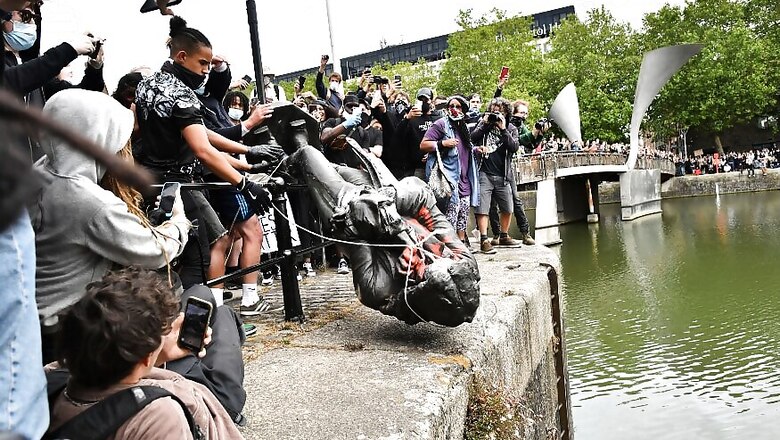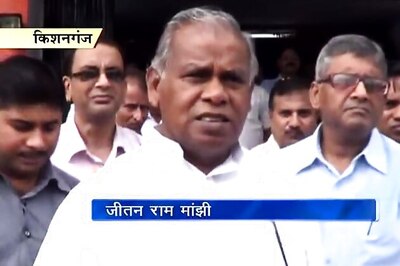
views
Statues are being toppled. Films are being pulled. People are being cancelled. No, this isn’t a list of lockdown pastimes or mob lingo. Well, it’s the ‘mob’ all right: not of the wise guys but the woke folks. And it’s all about making, and breaking, history.
On May 25, George Floyd, a 46-year-old black man, was killed in Minneapolis city of the United States during an arrest for allegedly using a counterfeit bill. Derek Chauvin, a white police officer, knelt on Floyd’s neck for nearly nine minutes while Floyd was handcuffed and lying face down in the street, pleading for his life and repeatedly saying “I can’t breathe”. The death lit a spark. And within a few days it spread across the world like wildfire, illuminating persisting problems of racism, tyranny, prejudice that exist in most countries, including India. Waves of protests, defying the menace of Covid-19, have forced authorities and privileged people to introspect and make corrections. The incident has turned into a tipping point, with more tangible changes in the offing. So far so good.
But there have also been bursts of rioting, looting and violence. All this is not uncommon for spontaneous protest movements like ‘Black Lives Matter’. Some troublemakers on the inside or infiltrators with ill intent try to profit and stir up chaos under the garb of a legitimate cause. Such actions have faced widespread condemnation.
Changing the ‘statues’ quo
What has found a groundswell of support, however, is a string of attacks on statues of historical figures with complex pasts. Those in the line of fire include the likenesses of Italian explorer (with a questionable compass as well as moral compass) Christopher Columbus, British Prime Minister and xenophobe Winston Churchill, English philanthropist and slave trader Edward Colston, and King Leopold II — the genocidal Belgian monarch and reformer. Some have been toppled, others defaced, and a few beheaded. As if being regularly pooped on by pigeons wasn’t humiliation enough. In some places, authorities have bowed to public pressure and removed such statues. And the hit list is growing rapidly.
Heads have rolled elsewhere, too. People in positions of power, celebrities, newspaper editors have either had to backtrack or step down after airing controversial views or just speaking against the popular sentiment. Some have been called out and attacked for past indiscretions.
The world of entertainment has also witnessed upheavals. The highest-grossing film in history (adjusted for inflation) ‘Gone with the Wind’ has lived up to its name, with streaming service HBO Max announcing that it has removed the Civil War epic “temporarily” from its collection over “racist depictions”. According to reports, Amazon might put the brakes on the 1980s-era show ‘Dukes of Hazzard’ — which features the Confederate flag emblazoned on the roof of the title characters’ muscle car — from playing on the IMDB TV digital platform.
Detractors say all this is just an extension of the cancel culture, art of taking offence and identity politics that are now pervasive across ideological divides and have found a megaphone in the form of social media.
Past imperfect
Much like their statues, almost all historical figures have feet of clay. Mohandas Karamchand Gandhi was a racist before he became ‘Mahatma’ (incidentally one of his monuments faced the wrath of a protest mob in Washington this month); and then there were his not-so-scientific experiments. Apart from being one of the world’s most influential thinkers, Aristotle was also a raving misogynist. Richard Wagner, who created some of the most revolutionary and soul-stirring musical compositions ever, was an anti-Semite. Renowned children’s author Enid Blyton was xenophobic and sexist.
Statues and monuments can mean different things to different people. They aren’t always symbols of glorification or a bid for immortality. They can also be viewed as bookmarks of history. Turn the page if you don’t want to read something, but maybe don’t burn the book. Historical figures can be reminders of what to do. Or what not to do. They can be reminders of the fact that human beings are not one-dimensional. We are complex creatures. A person can be responsible for lasting good and shocking evil in a lifetime. One doesn’t negate the other.
Valar morghulis
Questioning the past is fair, and often essential. But conducting moral autopsies of those long dead, and trying to tear down or purge the remnants and symbols of yesteryear — howsoever righteous the motivation may be in the eyes of the destroyer — are actions that are hard to justify and often have dangerous consequences. Those in support of the current spurt in wrecking or defacing pieces of history perhaps need to hark back to the fate of the Babri Masjid, the Bamiyan Buddhas, or the Temple of Bel.
Only someone incredibly dense would compare the acts of an anti-racism crowd with a terrorist group like ISIS destroying an ancient religious site. Right? Not quite. Different mobs have drastically different moral codes (none, in some cases) as well as understanding of right and wrong. The outcome, though, is very similar. Don’t expect others to play by your rules. What is a popular sentiment in one part of the world may be highly unpopular in another. And then there is time. Who is to say that, in a hundred years, today’s luminaries wouldn’t be wiped out of historical records for eating meat or keeping pets?
“Tomorrow is the most important thing in life. Comes into us at midnight very clean. It’s perfect when it arrives and it puts itself in our hands. It hopes we’ve learned something from yesterday.” Golden words from Hollywood legend and white supremacist John Wayne.
Read all the Latest News, Breaking News and Coronavirus News here.



















Comments
0 comment